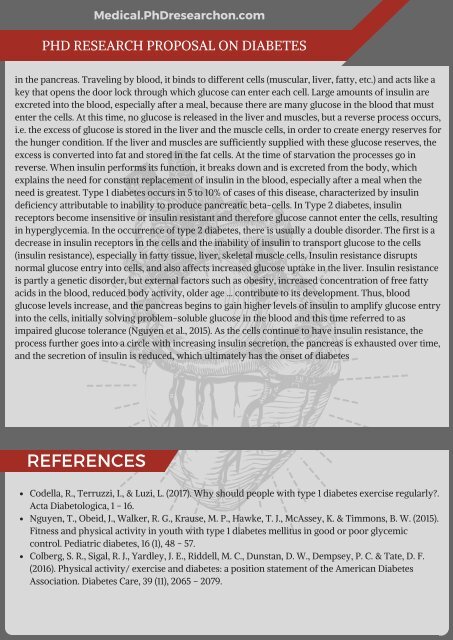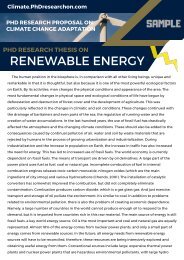Diabetes PhD Research Proposal Sample
Hello, here is a new sample of a diabetes PhD research proposal, learn more http://medical.phdresearchon.com/
Hello, here is a new sample of a diabetes PhD research proposal, learn more http://medical.phdresearchon.com/
Create successful ePaper yourself
Turn your PDF publications into a flip-book with our unique Google optimized e-Paper software.
Medical.<strong>PhD</strong>researchon.com<br />
PHD RESEARCH PROPOSAL ON DIABETES<br />
in the pancreas. Traveling by blood, it binds to different cells (muscular, liver, fatty, etc.) and acts like a<br />
key that opens the door lock through which glucose can enter each cell. Large amounts of insulin are<br />
excreted into the blood, especially after a meal, because there are many glucose in the blood that must<br />
enter the cells. At this time, no glucose is released in the liver and muscles, but a reverse process occurs,<br />
i.e. the excess of glucose is stored in the liver and the muscle cells, in order to create energy reserves for<br />
the hunger condition. If the liver and muscles are sufficiently supplied with these glucose reserves, the<br />
excess is converted into fat and stored in the fat cells. At the time of starvation the processes go in<br />
reverse. When insulin performs its function, it breaks down and is excreted from the body, which<br />
explains the need for constant replacement of insulin in the blood, especially after a meal when the<br />
need is greatest. Type 1 diabetes occurs in 5 to 10% of cases of this disease, characterized by insulin<br />
deficiency attributable to inability to produce pancreatic beta-cells. In Type 2 diabetes, insulin<br />
receptors become insensitive or insulin resistant and therefore glucose cannot enter the cells, resulting<br />
in hyperglycemia. In the occurrence of type 2 diabetes, there is usually a double disorder. The first is a<br />
decrease in insulin receptors in the cells and the inability of insulin to transport glucose to the cells<br />
(insulin resistance), especially in fatty tissue, liver, skeletal muscle cells. Insulin resistance disrupts<br />
normal glucose entry into cells, and also affects increased glucose uptake in the liver. Insulin resistance<br />
is partly a genetic disorder, but external factors such as obesity, increased concentration of free fatty<br />
acids in the blood, reduced body activity, older age ... contribute to its development. Thus, blood<br />
glucose levels increase, and the pancreas begins to gain higher levels of insulin to amplify glucose entry<br />
into the cells, initially solving problem-soluble glucose in the blood and this time referred to as<br />
impaired glucose tolerance (Nguyen et al., 2015). As the cells continue to have insulin resistance, the<br />
process further goes into a circle with increasing insulin secretion, the pancreas is exhausted over time,<br />
and the secretion of insulin is reduced, which ultimately has the onset of diabetes<br />
REFERENCES<br />
Codella, R., Terruzzi, I., & Luzi, L. (2017). Why should people with type 1 diabetes exercise regularly?.<br />
Acta Diabetologica, 1 - 16.<br />
Nguyen, T., Obeid, J., Walker, R. G., Krause, M. P., Hawke, T. J., McAssey, K. & Timmons, B. W. (2015).<br />
Fitness and physical activity in youth with type 1 diabetes mellitus in good or poor glycemic<br />
control. Pediatric diabetes, 16 (1), 48 - 57.<br />
Colberg, S. R., Sigal, R. J., Yardley, J. E., Riddell, M. C., Dunstan, D. W., Dempsey, P. C. & Tate, D. F.<br />
(2016). Physical activity/ exercise and diabetes: a position statement of the American <strong>Diabetes</strong><br />
Association. <strong>Diabetes</strong> Care, 39 (11), 2065 – 2079.





